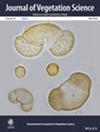A Virulent Soil Pathogen Alters Temperate Rain Forest Understorey Sapling Population Dynamics and Successional Trajectories
Abstract
Aims
Understanding the impacts of forest tree pathogens on understorey sapling populations is critical for understanding their population-level effects and the likely successional trajectories of infected communities. We assessed the impacts of Phytophthora agathidicida, a soil-borne pathogen, on the sapling population dynamics of the disease-susceptible, locally dominant canopy tree, the conifer kauri (Agathis australis, Araucariaceae). We also examined the indirect effects of P. agathidicida on likely resistant allospecifics that span a range of shade-tolerances as saplings, to predict future successional trajectories.
Location
Waitākere Ranges, west of Auckland, Aotearoa-New Zealand.
Methods
We analysed data from four kauri-dominated permanent plots in Aotearoa-New Zealand warm temperate rain forests. Two plots were early-successional and two were late-successional, one in each pair had overstorey kauri showing intense visual P. agathidicida symptoms, and the other overstorey kauri showing few symptoms. We examined the association between kauri trees and saplings using point pattern analysis and the relationship between the level of crowding around saplings and their growth and survival rates. We compared the growth and survival rates of kauri and allospecifics, categorised by shade tolerance, among the plots.
Results
Kauri forms sapling banks under conspecific trees that were less dense in late-successional forests and in those where the overstorey kauri showed symptoms of P. agathidicida infection. Despite having lower densities, kauri sapling growth rates were higher in symptomatic plots. The growth rates of light-demanding allospecifics were also higher in these plots, with minor differences in mortality and growth rates for more shade-tolerant allospecifics. P. agathidicida may promote sapling growth and survival of kauri and some allospecifics in infected plots.
Conclusions
Sapling vital rates and population sizes differed between asymptomatic and symptomatic plots, particularly in early-successional settings, where P. agathidicida may reset succession in early-successional communities back to those dominated by species that first colonised after disturbance.


 求助内容:
求助内容: 应助结果提醒方式:
应助结果提醒方式:


